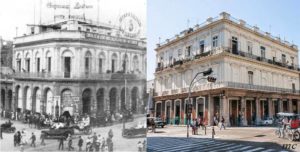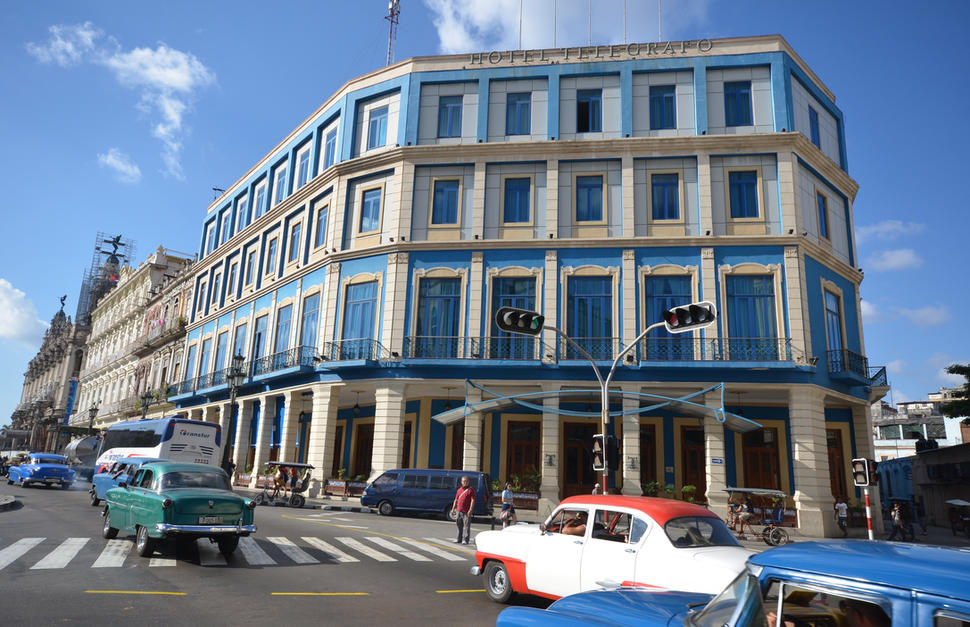 PRADO AND NEPTUNO, HAVANA, THE CORNER OF “LA ENGAÑADORA”.
PRADO AND NEPTUNO, HAVANA, THE CORNER OF “LA ENGAÑADORA”.
One of the most famous corners of the Cuban capital is that of Prado and Neptune, in that intersection there are hotels, restaurants, shops and, especially, groups of people who converse, walk, and let time pass in the legendary streets of Havana.
One of the oldest buildings is located in that direction: the Telegrafo hotel, which in 1860 was inaugurated on Amistad Street; and then, in 1899, moved to its current location.
But perhaps what has given fame to the famous corner of Havana, where the Caracas restaurant and the Parque Central hotel are located, is the rhythmic chachachá, which has been around the world and has been dancing for more than a generation.
Back in 1948, on the second floor of the building on that central corner, at the top of the restaurant, there was a dance hall where a smart party entrepreneur named Vicente Amores organized weekends, a dance party enlivened by an orchestra from fashion.
To the ballroom of Prado and Neptune all had the right to enter the dances, and many young people visited, especially students.
The orchestra contracted was the America, and was directed at that stage by Ninón Mondéjar, the musical director was Enrique Jorrín.
In that dance room, Jorrín unveiled a piece of music that was inscribed in the mambo-rumba genre and that was titled La Engañadora.
The same Enrique Jorrín had to declare more than once that the title was inspired by a young girl who entered the room very disheveled and went quickly to the bathroom, but when it came out it looked the most composed, well combed, make-up and elegantly dressed with a suit of pure thread. The musicians, who noticed the change so quickly, commented that this girl was cheating, and one of them exclaimed: “She is a cheat!”
That rhythm, danced as a couple, caused international furor, and became one of the emblematic musical themes of the 50s.
From the ballroom located in Prado and Neptuno there is only the memory left, but the corner was immortalized in the famous chachachá created in 1953 by Maestro Enrique Jorrín, a Cuban musician and composer.
PRADO Y NEPTUNO, LA HABANA, LA ESQUINA DE “LA ENGAÑADORA”.Una de las esquinas más famosas de la capital cubana es la de Prado y Neptuno, en esa intersección coinciden hoteles, restaurantes, tiendas y, en especial, grupos de personas que conversan, pasean, y dejan pasar el tiempo en las legendarias calles habaneras.
Uno de los edificios más antiguos está situado en esa dirección: el hotel Telégrafo, que en 1860 fuera inaugurado en la calle Amistad; y luego, en 1899, trasladado hasta su actual ubicación.
Pero quizás lo que más fama ha dado a la famosa esquina habanera, donde se ubican también el restaurante Caracas y el hotel Parque Central, es el rítmico chachachá , que ha dado la vuelta al mundo y puesto a bailar a más de una generación.
Allá por el año 1948 existía en el segundo piso del edificio de esa céntrica esquina, en los altos del restaurant, una sala de baile donde un avispado emprendedor de fiestas llamado Vicente Amores organizaba los fines de semana, una fiesta bailable amenizada por alguna orquesta de moda.
A la sala de baile de Prado y Neptuno todos tenían derecho de entrar a los bailes, y lo visitaban muchos jóvenes, sobre todo estudiantes.
La orquesta contratada era la América, y la dirigía en esa etapa Ninón Mondéjar, el director musical era Enrique Jorrín.
En esa sala de baile Jorrín dio a conocer una pieza musical que fue inscrita en el género mambo-rumba y que tituló La Engañadora.
El mismo Enrique Jorrín hubo de declarar más de una vez que ese título se lo inspiró una jovencita que entró a la sala muy desarreglada y se dirigió rápidamente al baño, pero cuando salió lucía de lo más compuesta, bien peinada, maquillada y elegantemente vestida con un traje de hilo puro. Los músicos, que se percataron del cambio tan rápido, comentaron que esa muchacha engañaba, y uno de ellos exclamó: “¡Es una engañadora!”
Ese ritmo, bailado en pareja, causó furor a nivel internacional, y se convirtió en uno de las temas musicales emblemáticos de los años 50.
Del salón de baile situado en Prado y Neptuno ya queda sólo el recuerdo, pero la esquina quedó inmortalizada en el famoso chachachá creado en 1953 por el Maestro Enrique Jorrín, músico y compositor cubano.
Agencies/RadioEnciclop/María Calvo/Internet Photos/ YouTube/ Arnoldo Varona/ TheCubanHistory.com
THE CUBAN HISTORY, HOLLYWOOD.








